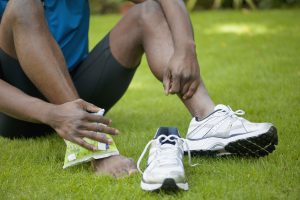Mountain Life: Preventing and Recovering from Ankle Sprains
If you live or play in the Tahoe mountains, your days might include hiking Desolation Wilderness, mountain biking Corral Trail, skiing Heavenly or Kirkwood, or chasing your dog along the beach. With so much uneven terrain and constantly changing weather, it’s no surprise ankle sprains are one of the most common injuries locals and visitors face.
An ankle sprain happens when the ligaments that support your ankle stretch or tear — usually when your heel is up and your toes hit uneven ground, causing the ankle to roll inward. Whether it happens on the slopes or during a trail run, taking the right steps early can make all the difference in recovery and preventing future injuries.
Why Ankle Ligaments Matter
Ligaments do more than just hold your bones together. They provide stability, guide movement, and play a key role in proprioception — your body’s ability to sense where your foot is in space. The ligaments on the outside of your ankle (the lateral ligaments) are the most commonly injured, but the inner ankle ligaments and the ligaments that connect your two lower leg bones can also be affected in more severe sprains, especially in high-impact mountain sports.
When to See a Healthcare Provider
If you suspect a sprain, don’t try to “walk it off.” A licensed healthcare provider or physical therapist can determine if you need imaging to rule out a fracture and guide you on how to protect your ankle while it heals. Ignoring the pain or skipping proper rehab can lead to chronic instability, recurrent sprains, and early arthritis — none of which mix well with Tahoe’s active lifestyle.
Seek care right away if you notice:
· Significant swelling or bruising
· Inability to bear weight after the injury
· Numbness, tingling, or a feeling that the ankle “gives out”
How to Care for a Sprain
In the first 48 hours, the classic RICE method — Rest, Ice, Compression, Elevation — can help manage swelling and pain. In some cases, your provider may recommend a brace, splint, or walking boot to protect the ankle as it heals. Early weight-bearing as tolerated is key to recovery, but don’t hesitate to use crutches if needed to avoid limping.
True healing happens through rehabilitation. A physical therapist will help you restore mobility, build ankle and hip strength, and retrain balance — all of which are essential for safely getting back to your favorite Tahoe activities.
A Simple Balance Exercise to Start
Once your ankle feels stronger, begin retraining your balance in a way that mimics your everyday activities — like stepping off uneven curbs, navigating rocky trails, or getting on and off your board or bike.
Try this early rehab balance drill: single-leg balance with reach. Stand on your injured leg and reach your other foot forward, to the side, and behind you, lightly tapping the ground each time. Repeat 10 times in each direction, keeping your weight steady on the supporting leg. This helps your ankle react to shifting balance, just like it does on uneven terrain.
Note: Do not continue with the exercise if you are experiencing sharp pain, increasing pain, or pain that lasts after you have completed the exercise.
Tahoe PT Tip
Living at elevation means your muscles fatigue faster and terrain changes quickly — both of which increase your risk for ankle injuries. Before hitting the trail or slopes, take five minutes to warm up with calf raises, ankle circles, and single-leg balance drills. Your ankles will thank you when the terrain gets rocky or icy!
Kirstyn Lipp is a physical therapist at Barton Rehabilitation and Sports Medicine. October is National Physical Therapy Month — a time to celebrate physical therapists and raise awareness about the benefits of physical therapists. Learn more about rehabilitation services, including physical therapy, at BartonHealth.org or by calling 530.539.6600.

Support Local Journalism

Support Local Journalism
Readers around the Lake Tahoe Basin and beyond make the Tahoe Tribune's work possible. Your financial contribution supports our efforts to deliver quality, locally relevant journalism.
Now more than ever, your support is critical to help us keep our community informed about the evolving coronavirus pandemic and the impact it is having locally. Every contribution, however large or small, will make a difference.
Your donation will help us continue to cover COVID-19 and our other vital local news.










